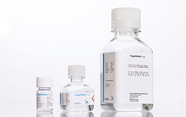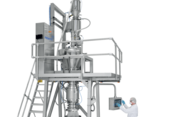Gene Therapy Research Roundup: Gene Circuits and Controlling Capsids With Machine Learning
We look at some of the latest studies and research announcements focused on improving gene therapy.
| 3 min read | News

Credit: Adobestock.com
Researchers at MIT have developed a synthetic gene circuit that uses microRNA to enable precise regulation of gene expression. The circuit (called an incoherent feedforward loop – IFFL) can maintain expression of a therapeutic gene within a specific range, minimizing risks associated with under- or overexpression, and has been tested in preclinical models of Fragile X syndrome.
According to MIT, “In an IFFL circuit, activation of the target gene simultaneously activates production of a molecule that suppresses gene expression. One type of molecule that can be used to achieve that suppression is microRN.”
Researchers can control the circuit using a promoter, and tailor how much of the therapeutic gene will be produced by using promoters of different strengths. In this case, the circuit was designed to express FMR1, the gene silenced in Fragile X syndrome, while also producing a microRNA that selectively binds to the FMR1 mRNA to dampen its translation. This creates a negative feedback loop: as levels of the therapeutic protein rise, microRNA-mediated suppression increases, limiting further expression.
The circuit was packaged into an AAV vector and delivered to the brains of Fmr1-knockout mice. In vivo, the feedback mechanism maintained FMRP expression within a range similar to that observed in wild-type controls. Importantly, the researchers demonstrated that modifying the strength of the promoter allowed them to shift the circuit’s expression “setpoint” while still preserving feedback regulation. Behavioral assays indicated that treated mice showed improvements in neurological symptoms associated with Fragile X syndrome, including enhanced performance in memory and anxiety-related tasks.
The team also validated that circuits lacking the microRNA feedback component either overproduced or underproduced FMRP, underscoring the importance of feedback in maintaining dosage within a therapeutic window.
Grants for gene-editing innovation in oncology
Swim Across America (SAA), a nonprofit organization that funds cancer research, has awarded two grants, each valued at $450,000, to the Alliance for Cancer Gene Therapy (ACGT) and Dana-Farber Cancer Institute.
At the University of Pennsylvania, Joseph Fraietta, will use the funding through ACGT to develop off-the-shelf cell therapies targeting aggressive cancers. His research involves the application of base editors to engineer CAR T cells that can more effectively target tumors with KRAS mutations. KRAS mutations are implicated in approximately 20 to 25 percent of cancers, including lung, colorectal, and pancreatic cancers. The work also explores engineering immune cells to act as localized micropharmacies, delivering therapeutic agents directly to tumor sites.
Pietro Genovese at Dana-Farber Cancer Institute will use the funding to pursue new strategies to treat acute myeloid leukemia (AML). His research focuses on engineering healthy blood cells to resist chemotherapy and selectively eliminate malignant cells, with the goal of developing less toxic therapeutic approaches for AML and potentially other hematologic malignancies.
Using machine learning to find the best capsids
Researchers at Sanofi have reported on a machine learning (ML) model that predicts how well adeno-associated virus (AAV) capsid mutants will perform in gene therapies. Traditionally, designing better capsids meant rounds of trial-and-error experiments. The new CAP-PLM tool uses a combination of protein language models and classical ML to forecast capsid "fitness" based solely on the protein’s amino acid sequence. The model achieved a high correlation with real-world data and proved reliable even when tested against completely independent sets of variants. This approach could improve library efficiency by filtering out nonviable variants and potentially enable exploration of novel capsid regions that are often overlooked in traditional screenings. Furthermore, the researchers highlight the future potential to extend the platform to other AAV serotypes and integrate it with generative models for even broader capsid innovation. Over time, smarter capsid engineering could help drive down production costs and make gene therapies far more accessible to patients.



















